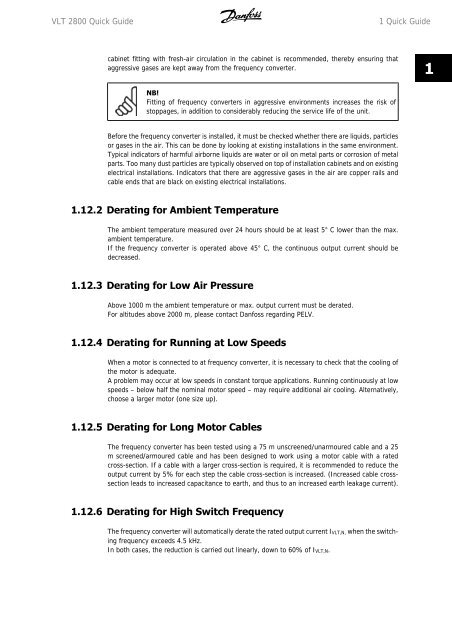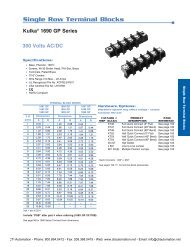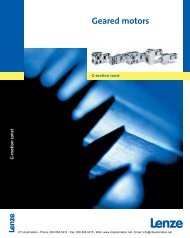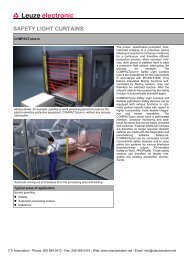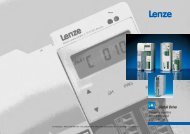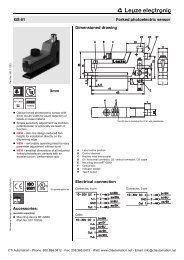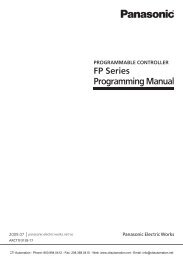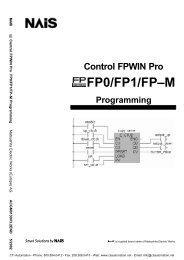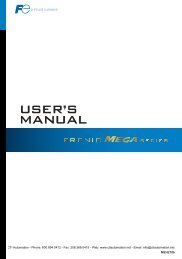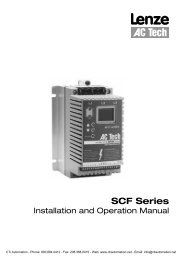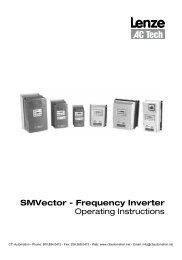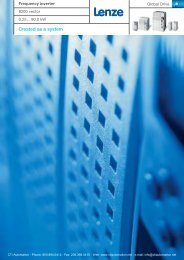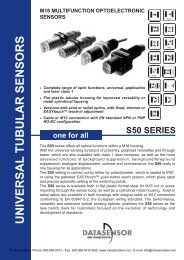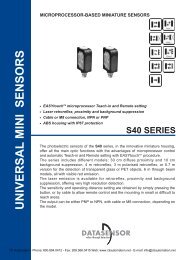Danfoss VLT 2800 Drives Quick Guide - CTi Automation
Danfoss VLT 2800 Drives Quick Guide - CTi Automation
Danfoss VLT 2800 Drives Quick Guide - CTi Automation
Create successful ePaper yourself
Turn your PDF publications into a flip-book with our unique Google optimized e-Paper software.
<strong>VLT</strong> <strong>2800</strong> <strong>Quick</strong> <strong>Guide</strong> 1 <strong>Quick</strong> <strong>Guide</strong><br />
cabinet fitting with fresh-air circulation in the cabinet is recommended, thereby ensuring that<br />
aggressive gases are kept away from the frequency converter.<br />
NB!<br />
Fitting of frequency converters in aggressive environments increases the risk of<br />
stoppages, in addition to considerably reducing the service life of the unit.<br />
Before the frequency converter is installed, it must be checked whether there are liquids, particles<br />
or gases in the air. This can be done by looking at existing installations in the same environment.<br />
Typical indicators of harmful airborne liquids are water or oil on metal parts or corrosion of metal<br />
parts. Too many dust particles are typically observed on top of installation cabinets and on existing<br />
electrical installations. Indicators that there are aggressive gases in the air are copper rails and<br />
cable ends that are black on existing electrical installations.<br />
1.12.2 Derating for Ambient Temperature<br />
The ambient temperature measured over 24 hours should be at least 5° C lower than the max.<br />
ambient temperature.<br />
If the frequency converter is operated above 45° C, the continuous output current should be<br />
decreased.<br />
1.12.3 Derating for Low Air Pressure<br />
Above 1000 m the ambient temperature or max. output current must be derated.<br />
For altitudes above 2000 m, please contact <strong>Danfoss</strong> regarding PELV.<br />
1.12.4 Derating for Running at Low Speeds<br />
When a motor is connected to at frequency converter, it is necessary to check that the cooling of<br />
the motor is adequate.<br />
A problem may occur at low speeds in constant torque applications. Running continuously at low<br />
speeds – below half the nominal motor speed – may require additional air cooling. Alternatively,<br />
choose a larger motor (one size up).<br />
1.12.5 Derating for Long Motor Cables<br />
The frequency converter has been tested using a 75 m unscreened/unarmoured cable and a 25<br />
m screened/armoured cable and has been designed to work using a motor cable with a rated<br />
cross-section. If a cable with a larger cross-section is required, it is recommended to reduce the<br />
output current by 5% for each step the cable cross-section is increased. (Increased cable crosssection<br />
leads to increased capacitance to earth, and thus to an increased earth leakage current).<br />
1.12.6 Derating for High Switch Frequency<br />
The frequency converter will automatically derate the rated output current I<strong>VLT</strong>,N, when the switching<br />
frequency exceeds 4.5 kHz.<br />
In both cases, the reduction is carried out linearly, down to 60% of I<strong>VLT</strong>,N.<br />
MG.28.M1.02 - <strong>VLT</strong> ® is a registered <strong>Danfoss</strong> trademark 33<br />
1


